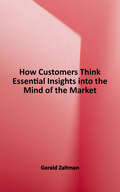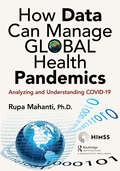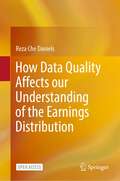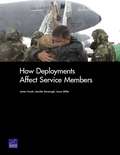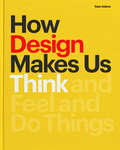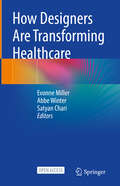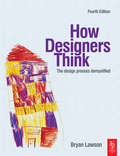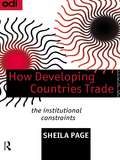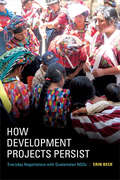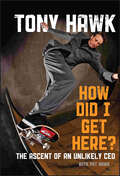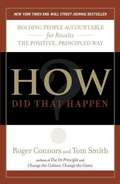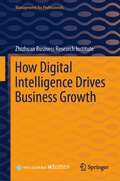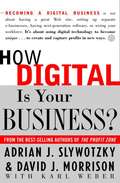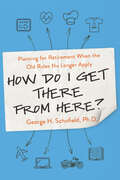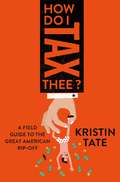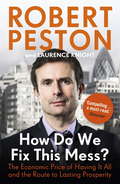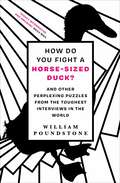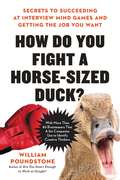- Table View
- List View
How Customers Think: Essential Insights into the Mind of the Market
by Gerald ZaltmanHow to unlock the hidden 95 percent of the customer's mind that traditional marketing methods have never reached. This title provides a practical synthesis of the cognitive sciences. Drawing heavily on psychology, neuroscience, sociology, and linguistics, Zaltman combines academic rigor with real-world results to offer highly accessible insights, based on his years of research and consulting work with large clients like Coca-Cola and Procter & Gamble. An all-new tool kit: Zaltman provides research tools - metaphor elicitation, response latency, and implicit association techniques, to name a few - that will be all-new to marketers, and demonstrates how innovators can use these tools to get clues from the subconscious when developing new products and finding new solutions, long before competitors do.
How Data Can Manage Global Health Pandemics: Analyzing and Understanding COVID-19 (HIMSS Book Series)
by Rupa Mahanti"This book bridges the fields of health care and data to clarify how to use data to manage pandemics. Written while COVID-19 was raging, it identifies both effective practices and misfires, and is grounded in clear, research-based explanations of pandemics and data strategy….The author has written an essential book for students and professionals in both health care and data. While serving the needs of academics and experts, the book is accessible for the general reader." – Eileen Forrester, CEO of Forrester Leadership Group, Author of CMMI for Services, Guidelines for Superior Service "…Rupa Mahanti explores the connections between data and the human response to the spread of disease in her new book,... She recognizes the value of data and the kind of insight it can bring, while at the same time recognizing that using data to solve problems requires not just technology, but also leadership and courage. This is a book for people who want to better understand the role of data and people in solving human problems." -- Laura Sebastian-Coleman, Author of Meeting the Challenges of Data Quality Management In contrast to the 1918 Spanish flu pandemic which occurred in a non-digital age, the timing of the COVID-19 pandemic intersects with the digital age, characterized by the collection of large amounts of data and sophisticated technologies. Data and technology are being used to combat this digital age pandemic in ways that were not possible in the pre-digital age. Given the adverse impacts of pandemics in general and the COVID-19 pandemic in particular, it is imperative that people understand the meaning, origin of pandemics, related terms, trajectory of a new disease, butterfly effect of contagious diseases, factors governing the pandemic potential of a disease, strategies to combat a pandemic, role of data, data sharing, data strategy, data governance, analytics, and data visualization in managing pandemics, pandemic myths, critical success factors in managing pandemics, and lessons learned. How Data Can Manage Global Health Pandemics: Analyzing and Understanding COVID-19 discusses these elements with special reference to COVID-19. Dr. Rupa Mahanti is a business and data consultant and has expertise in different data management disciplines, business process improvement, regulatory reporting, quality management, and more. She is the author of Data Quality (ASQ Quality Press) and the series Data Governance: The Way Forward (Springer).
How Data Quality Affects our Understanding of the Earnings Distribution
by Reza Che DanielsThis open access book demonstrates how data quality issues affect all surveys and proposes methods that can be utilised to deal with the observable components of survey error in a statistically sound manner. This book begins by profiling the post-Apartheid period in South Africa's history when the sampling frame and survey methodology for household surveys was undergoing periodic changes due to the changing geopolitical landscape in the country. This book profiles how different components of error had disproportionate magnitudes in different survey years, including coverage error, sampling error, nonresponse error, measurement error, processing error and adjustment error. The parameters of interest concern the earnings distribution, but despite this outcome of interest, the discussion is generalizable to any question in a random sample survey of households or firms. This book then investigates questionnaire design and item nonresponse by building a response propensity model for the employee income question in two South African labour market surveys: the October Household Survey (OHS, 1997-1999) and the Labour Force Survey (LFS, 2000-2003). This time period isolates a period of changing questionnaire design for the income question. Finally, this book is concerned with how to employee income data with a mixture of continuous data, bounded response data and nonresponse. A variable with this mixture of data types is called coarse data. Because the income question consists of two parts -- an initial, exact income question and a bounded income follow-up question -- the resulting statistical distribution of employee income is both continuous and discrete. The book shows researchers how to appropriately deal with coarse income data using multiple imputation. The take-home message from this book is that researchers have a responsibility to treat data quality concerns in a statistically sound manner, rather than making adjustments to public-use data in arbitrary ways, often underpinned by undefensible assumptions about an implicit unobservable loss function in the data. The demonstration of how this can be done provides a replicable concept map with applicable methods that can be utilised in any sample survey.
How Deployments Affect Service Members
by Laura L. Miller Jennifer Erin Kavanagh James HosekTo offer insights into the challenges faced by active-duty service members deployed to Iraq and Afghanistan and their families in coping with these challenges, and the adequacy of defense manpower policy in assisting members and families, this monograph draws on the perspectives of economics, sociology, and psychology; provides a formal model of deployment and retention; reviews published work; reports on the results of focus groups conducted in each of the services; and presents findings from an analysis of survey data.
How Design Makes Us Think: And Feel and Do Things
by Sean AdamsFrom posters to cars, design is everywhere. While we often discuss the aesthetics of design, we don't always dig deeper to unearth the ways design can overtly, and covertly, convince us of a certain way of thinking. How Design Makes Us Think collects hundreds of examples across graphic design, product design, industrial design, and architecture to illustrate how design can inspire, provoke, amuse, anger, or reassure us.Graphic designer Sean Adams walks us through the power of design to attract attention and convey meaning. The book delves into the sociological, psychological, and historical reasons for our responses to design, offering practitioners and clients alike a new appreciation of their responsibility to create design with the best intentions. How Design Makes Us Think is an essential read for designers, advertisers, marketing professionals, and anyone who wants to understand how the design around us makes us think, feel, and do things.
How Designers Are Transforming Healthcare
by Evonne Miller Abbe Winter Satyan ChariThis is an open access book.How Designers are Transforming Healthcare is a bold manifesto for change, demonstrating the value of a strategic design-led approach. Drawing on a rich array of real-world projects, this book illustrates how designers, in collaboration with clinicians and consumers, are co-creating transformative change across healthcare environments, products, services, and systems.In a fascinating multi-voice conversation, this book outlines how design methods and mindsets, including co-design, prototyping, design and futures thinking, facilitates creative problem-solving. The ideas, tools, and challenges in How Designers are Transforming Healthcare make it a vital text - a doer’s guide - for designers, clinicians, academics, consumers, and policymakers seeking innovative strategies for engagement, innovation and improvement in healthcare.
How Designers Think: The Design Process Demystified
by Bryan LawsonHow Designers Think is based on Bryan Lawson's many observations of designers at work, interviews with designers and their clients and collaborators. This extended work is the culmination of forty years' research and shows the belief that we all can, and do, design, and that we can learn to design better. The creative mind continues to have the power to surprise and this book aims to nurture and extend this creativity. Neither the earlier editions, nor this book, are intended as authoritative prescriptions of how designers should think but provide helpful advice on how to develop an understanding of design.In this fourth edition, Bryan Lawson continues to try and understand how designers think, to explore how they might be better educated and to develop techniques to assist them in their task. Some chapters have been revised and three completely new chapters added. The book is now intended to be read in conjunction with What Designers Know which is a companion volume. Some of the ideas previously discussed in the third edition of How Designers Think are now explored more thoroughly in What Designers Know. For the first time this fourth edition works towards a model of designing and the skills that collectively constitute the design process.
How Developing Countries Trade: The Institutional Constraints
by Sheila PageOver the last fifteen years there have been dramatic increases in both private and public intervention in international trade. Traditional barriers to market-based trade such as commodity cartels and tariffs have been augmented by new developments such as the rise of regional trade blocs and the growth of intra-firm trade. This book argues that the
How Development Projects Persist: Everyday Negotiations with Guatemalan NGOs
by Erin BeckIn How Development Projects Persist Erin Beck examines microfinance NGOs working in Guatemala and problematizes the accepted wisdom of how NGOs function. Drawing on twenty months of ethnographic fieldwork, she shows how development models and plans become entangled in the relationships among local actors in ways that alter what they are, how they are valued, and the conditions of their persistence. Beck focuses on two NGOs that use drastically different methods in working with poor rural women in Guatemala. She highlights how each program's beneficiaries—diverse groups of savvy women—exercise their agency by creatively appropriating, resisting, and reinterpreting the lessons of the NGOs to match their personal needs. Beck uses this dynamic—in which the goals of the developers and women do not often overlap—to theorize development projects as social interactions in which policymakers, workers, and beneficiaries critically shape what happens on the ground. This book displaces the notion that development projects are top-down northern interventions into a passive global south by offering a provocative account of how local conditions, ongoing interactions, and even fundamental tensions inherent in development work allow such projects to persist, but in new and unexpected ways.
How Did I Get Here
by Pat Hawk Tony HawkThe most famous skateboarder ever shares the business secrets to his success!He's the man who put skateboarding on the map. He's the first to land a 900 (two and a half full rotations). He's also among the richest pitchmen in any sport. And, in a sport that's especially youth-oriented, Tony Hawk, a 40-something father of four, still connects with his audience by staying true to who he is.Moving easily between the ramp and the boardroom, Tony currently runs one of the most acclaimed action sports companies, a clothing line, and video game series bearing his name that has sold over $1 billion worldwide, making it the biggest selling action sports game franchise in game history. He has secured endorsement deals with major brands such as McDonalds, Intel, T-Mobile and Kohl's; started the Boom Boom HuckJam action sports tour; and achieved worldwide acclaim from the ESPN X Games.Filled with Tony's typical modesty and humor, How Did I Get Here? tells the amazing story behind Tony Hawk's unprecedented success from skateboarder to CEO, and the secrets behind his lasting appeal. You'll find out how authenticity has served him well in all his achievements. You'll also understand how his story has shaped many of his fundamental values, including his huge desire to win and his strong sense of realism.Get the inside story of Tony Hawk beyond the skateboard as he answers the question: How Did I Get Here?
How Did That Happen?
by Roger Connors Tom SmithThe New York Times bestseller that provides a simple, proven approach to improve accountability and the bottom line. The economy crashes, the government misfires, businesses fail, leaders don't lead, managers don't manage, and people don't follow through, leaving us asking, "How did that happen?" Surprises caused by a lack of personal accountability plague almost every organization today, from the political arena to large and small businesses. How Did That Happen? offers a proven way to eliminate these nasty surprises, gain an unbeatable competitive edge, and enhance performance by holding others accountable the positive, principled way. As the experts on workplace accountability and the authors of The Oz Principle, Roger Connors and Tom Smith tackle the next crucial step everyone can take, whether working as a manager, supervisor, CEO, or individual performer: creating greater accountability in all the people on whom you depend.
How Digital Intelligence Drives Business Growth (Management for Professionals)
by Zhizhuan Business Research InstituteThis book aims to build a framework for understanding how to achieve new business growth through digital intelligence. It reveals the driving force and commercial logic behind the technology upgrade and transformation for enterprises, analyzes how to improve enterprises' branding, product, distribution channel, marketing, logistics, and organization under the new context, and studies the successful cases in digital intelligence of 6 Chinese enterprises. For business school students, researchers, managers, and practitioners, it is helpful to build an overview and understanding on strategy level as well as practice level.
How Digital Is Your Business?
by Adrian J. Slywotzky David Morrison Karl WeberThe biggest, most important issue in business today--becoming digital--touches not only traditional enterprises but the most avant-garde of Internet companies as well.Old-economy companies must take steps to avoid becoming victims of capitalism's creative destruction, the unofficial system that flushes out the old to make way for the new. For dot-com companies the question is whether or not they are flash-in-the-pan businesses with no long-term prospects of profitability and customer loyalty.Most of the early efforts to answer the question "How digital is your business?" have been shrouded in techno-speak: a veritable Tower of Babel unconnected with the real needs of business. Slywotzky and Morrison show, first of all, that becoming digital is not about any of the following: having a great Web site, setting up a separate e-business, having next-generation software, or wiring your workforce.What they so creatively demonstrate is that a digital business is one whose strategic options have been transformed--and significantly broadened--by the use of digital technologies. A digital business has strategic differentiation, a business model that creates and captures profits in new ways and develops powerful new value propositions for customers and talent. Above all, a digital business is one that is unique.How Digital Is Your Business? is a groundbreaking book with universal appeal for everyone in the business world. It offers:* Profiles of the future: the in-depth story of the digital pioneers--Dell Computer, Charles Schwab, Cisco Systems, Cemex.* Insight into how to change a traditional enterprise into a digital business: the stories of GE and IBM. * An analysis of the profitable dot-coms: AOL, Yahoo!, and eBay.While How Digital Is Your Business? has great stories and case studies, its most invaluable central idea is that of digital business design and the array of powerful digital tools it offers for use in creating a digital future for your own company.
How Do I Get There from Here?: Planning for Retirement When the Old Rules No Longer Apply
by George H. SchofieldNo matter how far or close you think you are to retirement, this book is your one-stop guide to help you plot your direction for the coming decades.Not long ago everyone knew what the word retirement meant--retire at age 65 after 40 years at the same job and coast through your golden years courtesy of a comfortable nest egg. But now, age expectancy is higher, savings are slimmer, and people change jobs more frequently. Clinging to this outdated concept of retirement only gets you a room in your kids&’ house. Your retirement is going to require an incremental approach to planning--and you must begin now. This requires conscious engagement, diverse interests, and the ability to adapt.In How Do I Get There from Here?, readers will first be directed how to review all their assets--both tangible and intangible--so they can get an honest assessment of where they are right now. Then a journey through self-reflective questions and exercises will:walk you through imagining your future,identifying skills you&’ll need,and learning how to prepare for inevitable twists and turns along the way.Stop clinging to an ancient and stereotypical idea of retirement. Decades of nonstop leisure is not only unreachable for most, it&’s not even truly desirable. Begin now charting the path for a unique, dynamic future you can look forward to!
How Do I Tax Thee?: A Field Guide to the Great American Rip-Off
by Kristin TateLibertarian journalist Kristin Tate provides a look into the wild world of frivolous taxation, aimed at educating members of her own generation in the evils of big government.In How Do I Tax Thee?, libertarian commentator and rising media star Kristin Tate takes us on a tour of the ways the government bleeds us dry in innumerable daily transactions and at various stages of life. We all know the government taxes our pay: federal, state, and local taxes are withheld by employers, as are social security payments. But what about the many other ways the government drains money from our wallets? Have you studied your cell phone bill? Customers in New York State pay an average of 24.36% in federal, state and local taxes on their wireless bills. They’re also charged for obscure services they didn’t ask for and don’t understand like a universal service fund fee, an FCC compliance fee, a line service fee, and an emergency services fee. These aren’t taxes, strictly speaking. The government imposes these administrative and regulatory costs, and your wireless provider passes them along to you. But the effect is exactly the same. What about your cable bill? Your power bill? Your water bill? The cost of a gallon of gas, a cab ride, a hotel stay and a movie ticket are all inflated by hidden fees. How much of what you pay at the pump, the box office, or the airport is really an indirect tax? In a series of short, pointed, fact-laden, humorous chapters, Tate exposes the vast government shakedown that consumes up to half of your income—and also explains where these hidden fees and taxes come from.
How Do We Begin?: Teaching Adaptive Leadership
by Sharon D. ParksThis chapter steps directly into a classroom in which the case-in-point teaching method is used, immersing the reader in the actual dynamics of the opening session of a course on Exercising Leadership at Harvard.
How Do We Fix This Mess?
by Robert PestonIn Robert Peston's new book he explains in his characteristically straightforward way how the world got itself into the current economic mess - and how we might get out of it. 'How do we fix this mess? I don't know. But don't stop reading now. Perhaps if we have a clearer understanding of what went wrong, we'll have a better idea of what needs to be done. This book is a map of what needs to be fixed.' The record-breaking unbroken growth between 1992 and 2008 wasn't the economic miracle that it seemed. It was based on a number of dangerous illusions - most notably that it didn't matter that the UK and US year after year consumed more than they earned. But we couldn't go on increasing our indebtedness forever. The financial crash of 2007/8 and the subsequent economic slump in much of the west was the moment when we realised we had borrowed more than we could afford to repay. So who got it wrong? Bankers, investors and regulators? And were they greedy, stupid or asleep? What was the role of government? And what part did we, as consumers, play in all this? How do we get through this difficult period of transition to a more sustainable economy, one based on investment and exports, rather than on borrowing and consumption? With the same probing lucidity he brought to WHO RUNS BRITAIN?, Robert Peston takes us step-by-step towards a common sense way to fix this mess.
How Do We Fix This Mess? The Economic Price of Having it all, and the Route to Lasting Prosperity
by Robert Peston'Robert Peston's compelling account of global financial meltdown is a must-read.' ObserverWhat can we learn from the 2008 recession? ITV's political editor explains the global economic mess and how to escape it - in his characteristically straightforward way. 'How do we fix this mess? I don't know. But don't stop reading now. Perhaps if we have a clearer understanding of what went wrong, we'll have a better idea of what needs to be done. This book is a map of what needs to be fixed.'The record-breaking unbroken growth between 1992 and 2008 wasn't the economic miracle that it seemed. It was based on a number of dangerous illusions - most notably that it didn't matter that the UK and US year after year consumed more than they earned.But we couldn't go on increasing our indebtedness forever. The financial crash of 2007/8 and the subsequent economic slump in much of the west was the moment when we realised we had borrowed more than we could afford to repay.So who got it wrong? Bankers, investors and regulators? And were they greedy, stupid or asleep? What was the role of government? And what part did we, as consumers, play in all this? How do we get through this difficult period of transition to a more sustainable economy, one based on investment and exports, rather than on borrowing and consumption? With the same probing lucidity he brought to Who Runs Britain? and WTF?, Robert Peston takes us step-by-step towards a common sense way to fix this mess.
How Do You Fight a Horse-Sized Duck?: And Other Perplexing Puzzles from the Toughest Interviews in the World
by William PoundstoneEvery year, millions of applications stream to a handful of companies that regularly top the listings of best employers: Apple, Netflix, Amazon, Alphabet, Disney, SpaceX, Oracle, PricewaterhouseCoopers and others. In 2017, Tesla received as many as 200 applications for each vacancy, making it ten times more selective than Harvard. The only way to choose who to hire is with uniquely demanding questions that test imagination, persistence and creativity. Questions like: How is a milk carton like a plane seat? Why don&’t animals have wheels? What would happen if you drilled a hole all the way through the Earth and jumped in it? How Do You Fight a Horse-Sized Duck? explores the new world of interviewing at A-list employers. It reveals more than 70 outrageously perplexing riddles and puzzles and supplies both answers and general strategy for creative problem-solving.
How Do You Fight a Horse-Sized Duck?: Secrets to Succeeding at Interview Mind Games and Getting the Job You Want
by William PoundstoneLearn how to succeed at interview mind games and win job offers at A‑list companies, with more than eighty difficult and devious questions, puzzles, and brain teasersEach year about 28 million Americans begin a search for a new job. Many more live in the age of the permanent job search, their online profiles eternally awaiting a better offer. Job seekers are more mobile and better informed than ever, aspiring to work for employers offering an appealing culture, a robust menu of perks, and opportunities for personal fulfillment and advancement. The result is that millions of applications stream to the handful of companies that regularly top listings of the best companies to work for: Apple, Netflix, Amazon, Alphabet, Disney, SpaceX, Oracle, Pricewaterhouse-Coopers, and others. Tesla has received as many as 200 applications for each open position. How do selective employers choose which people to hire? It&’s through interviews asking uniquely demanding questions testing imagination, persistence, and creativity, like: Can an astronaut throw a baseball so it hits Earth? If you had $2,000, how would you double it in 24 hours? How is a milk carton like a plane seat? Chicken McNuggets come in boxes of 6, 9, and 20. What&’s the largest number of McNuggets that McDonald&’s can&’t sell you? How many dogs in the world have the exact same number of hairs?How Do You Fight a Horse-Sized Duck? explores the new world of interviewing at A-list employers. It reveals more than eighty notoriously challenging interview questions and supplies both answers and a general strategy for creative problem-solving.
How Do You Find What Matters in Experience?: Becoming a More Effective Leader
by Robert J. ThomasHow do leaders grow and improve? This chapter describes crucible experiences-experiences that lead to a new or altered sense of identity-and more importantly, leaders' reactions to crucible experiences, as central to enhancing leadership performance.
How Do You Grow a Premium Brand? (HBR Case Study and Commentary)
by Anita K. Hersh Peter H. Farquhar Robert J. Dolan Mary Shelman David A. Aaker William Campbell Regina Fazio MarucaGordon Johnston has taken his elite health-club concept from the germ of an idea to the pinnacle of success. But the most difficult decision in managing his company lies ahead. Gordon must figure out how to lead Transition fitness clubs into the next phase. In each of the 15 years since Transition's flagship club opened in New York City, its sales have doubled. The company boasts fitness trainers handpicked by Olympic medalists, health-conscious cuisine by in-house chefs, huge facilities in prime locations, and reciprocal memberships at other Transition clubs worldwide. But recently, the company's margins have been shrinking. An aging membership could mean problems for future expansion. And new, upscale competitors are challenging Transition's flat-rate pricing policy. Will Gordon have to run fast to stay in one place? Should he change Transition's pricing policy? In 95205 and 95205Z, William Campbell, Robert J. Dolan, Anita K. Hersh, Peter H. Farquhar, David Aaker, and Mary Shelman offer advice on this fictional case study.
How Do You Know When the Price Is Right?
by Robert J. DolanToo often when managers think about pricing, the first question they ask is, What should the price be? In fact, what they should be asking is, Have we addressed all the considerations that will determine the correct price? Robert J. Dolan describes two broad qualities of an effective pricing process and provides eight steps to enable managers to develop and use such a process. The pricing scorecard included at the end of the article will allow managers to evaluate how well their pricing practices meet these guidelines.
How do You Make Money Renting Toys?: Technical guide for beginners – Book I
by Pílula DigitalAll the strategies and information that you will read in this book, and that I learned when I entered the business of renting toys for parties and events, are the result of my professional experiences in this area. Although I have made every effort to ensure the accuracy and highest quality of this information to make the techniques and methods taught here highly effective for anyone willing to learn and apply them, these methods and information have not been tested or proven scientifically, but in practice. The strategies and information presented here are for everyone, but they are not for everybody. You need to be eager to learn them.
How Do You Manage an Off-Site Team? (HBR Case Study and Commentary)
by John R. Birstler Robert M. Egan Margaret Klayton-Mi Wendy Miles Regina Fazio MarucaIn this fictitious case study, HBR editor Regina F. Maruca explores the challenges of managing employees in the alternative workplace. Allison Scher is threatening to quit. Penny Ryan wants to run the team. The manager of these off-site workers, Craig Bedell, feels blindsided by their conflict. And the whole mess has Maggie Pinto, the head of HR, wondering if she should cancel the companywide rollout of the telecommuting program. How did this situation get to the boiling point so quickly? Craig doesn't really know. From his vantage point--inside the office--his department is doing the best work it has ever done before. And the flexible work arrangements, designed on a case-by-case basis, have increased productivity and boosted morale at the same time. Or so Craig believed--until a few days ago, when the E-mail messages started to come. There was trouble between Penny and Allison. How serious was the situation? It was hard to tell. Craig responded with E-mail and voice-mail messages of his own. Couldn't it all be put on hold until Monday, when the team would come together for its biweekly meeting? Then he got the final E-mail from Allison--the one in which she threatened "to seek alternative employment." Is the breakdown in communication irrevocable? Can Craig, who learned how to manage during a time when people showed up at the office every day, adjust to the conditions of telecommuting? Four commentators offer their advice on how the company can patch up the short-term problem and lay the foundation for a successful future. In 98405 and 98405Z, Robert M. Egan, Wendy Miles, John R. Birstler, and Margaret Klayton-Mi offer their advice on how the company can patch up the short-term problem and lay the foundation for a successful future.
